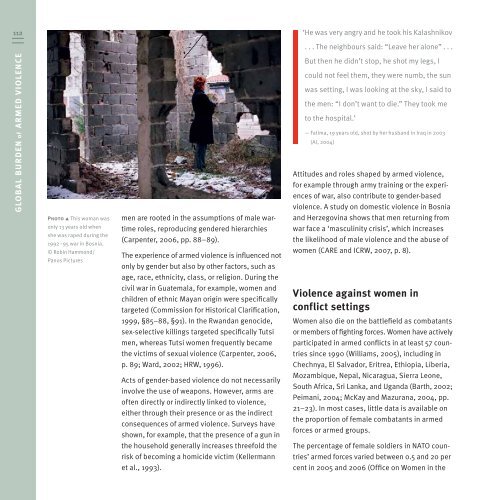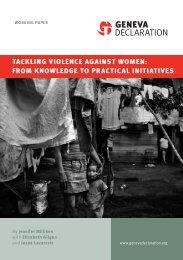Global Burden of Armed Violence - The Geneva Declaration on ...
Global Burden of Armed Violence - The Geneva Declaration on ...
Global Burden of Armed Violence - The Geneva Declaration on ...
You also want an ePaper? Increase the reach of your titles
YUMPU automatically turns print PDFs into web optimized ePapers that Google loves.
112<br />
GLOBAL BURDEN <str<strong>on</strong>g>of</str<strong>on</strong>g> ARMED VIOLENCE<br />
Photo ! This woman was<br />
<strong>on</strong>ly 13 years old when<br />
she was raped during the<br />
1992–95 war in Bosnia.<br />
© Robin Hamm<strong>on</strong>d/<br />
Panos Pictures<br />
men are rooted in the assumpti<strong>on</strong>s <str<strong>on</strong>g>of</str<strong>on</strong>g> male wartime<br />
roles, reproducing gendered hierarchies<br />
(Carpenter, 2006, pp. 88–89).<br />
<str<strong>on</strong>g>The</str<strong>on</strong>g> experience <str<strong>on</strong>g>of</str<strong>on</strong>g> armed violence is influenced not<br />
<strong>on</strong>ly by gender but also by other factors, such as<br />
age, race, ethnicity, class, or religi<strong>on</strong>. During the<br />
civil war in Guatemala, for example, women and<br />
children <str<strong>on</strong>g>of</str<strong>on</strong>g> ethnic Mayan origin were specifically<br />
targeted (Commissi<strong>on</strong> for Historical Clarificati<strong>on</strong>,<br />
1999, §85–88, §91). In the Rwandan genocide,<br />
sex-selective killings targeted specifically Tutsi<br />
men, whereas Tutsi women frequently became<br />
the victims <str<strong>on</strong>g>of</str<strong>on</strong>g> sexual violence (Carpenter, 2006,<br />
p. 89; Ward, 2002; HRW, 1996).<br />
Acts <str<strong>on</strong>g>of</str<strong>on</strong>g> gender-based violence do not necessarily<br />
involve the use <str<strong>on</strong>g>of</str<strong>on</strong>g> weap<strong>on</strong>s. However, arms are<br />
<str<strong>on</strong>g>of</str<strong>on</strong>g>ten directly or indirectly linked to violence,<br />
either through their presence or as the indirect<br />
c<strong>on</strong>sequences <str<strong>on</strong>g>of</str<strong>on</strong>g> armed violence. Surveys have<br />
shown, for example, that the presence <str<strong>on</strong>g>of</str<strong>on</strong>g> a gun in<br />
the household generally increases threefold the<br />
risk <str<strong>on</strong>g>of</str<strong>on</strong>g> becoming a homicide victim (Kellermann<br />
et al., 1993).<br />
‘He was very angry and he took his Kalashnikov<br />
. . . <str<strong>on</strong>g>The</str<strong>on</strong>g> neighbours said: “Leave her al<strong>on</strong>e” . . .<br />
But then he didn’t stop, he shot my legs, I<br />
could not feel them, they were numb, the sun<br />
was setting, I was looking at the sky, I said to<br />
the men: “I d<strong>on</strong>’t want to die.” <str<strong>on</strong>g>The</str<strong>on</strong>g>y took me<br />
to the hospital.’<br />
— Fatima, 19 years old, shot by her husband in Iraq in 2003<br />
(AI, 2004)<br />
Attitudes and roles shaped by armed violence,<br />
for example through army training or the experiences<br />
<str<strong>on</strong>g>of</str<strong>on</strong>g> war, also c<strong>on</strong>tribute to gender-based<br />
violence. A study <strong>on</strong> domestic violence in Bosnia<br />
and Herzegovina shows that men returning from<br />
war face a ‘masculinity crisis’, which increases<br />
the likelihood <str<strong>on</strong>g>of</str<strong>on</strong>g> male violence and the abuse <str<strong>on</strong>g>of</str<strong>on</strong>g><br />
women (CARE and ICRW, 2007, p. 8).<br />
<str<strong>on</strong>g>Violence</str<strong>on</strong>g> against women in<br />
c<strong>on</strong>flict settings<br />
Women also die <strong>on</strong> the battlefield as combatants<br />
or members <str<strong>on</strong>g>of</str<strong>on</strong>g> fighting forces. Women have actively<br />
participated in armed c<strong>on</strong>flicts in at least 57 countries<br />
since 1990 (Williams, 2005), including in<br />
Chechnya, El Salvador, Eritrea, Ethiopia, Liberia,<br />
Mozambique, Nepal, Nicaragua, Sierra Le<strong>on</strong>e,<br />
South Africa, Sri Lanka, and Uganda (Barth, 2002;<br />
Peimani, 2004; McKay and Mazurana, 2004, pp.<br />
21–23). In most cases, little data is available <strong>on</strong><br />
the proporti<strong>on</strong> <str<strong>on</strong>g>of</str<strong>on</strong>g> female combatants in armed<br />
forces or armed groups.<br />
<str<strong>on</strong>g>The</str<strong>on</strong>g> percentage <str<strong>on</strong>g>of</str<strong>on</strong>g> female soldiers in NATO countries’<br />
armed forces varied between 0.5 and 20 per<br />
cent in 2005 and 2006 (Office <strong>on</strong> Women in the









